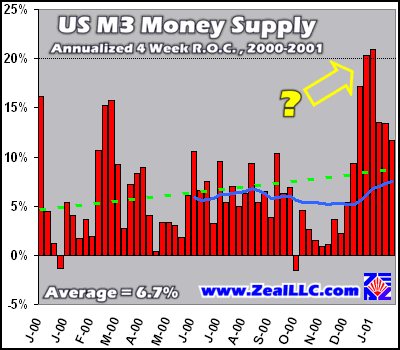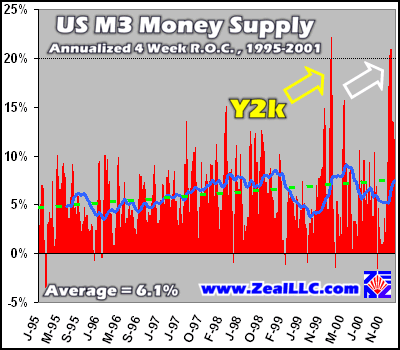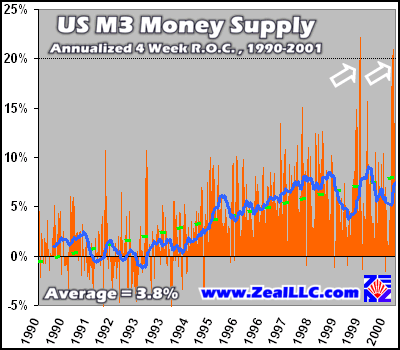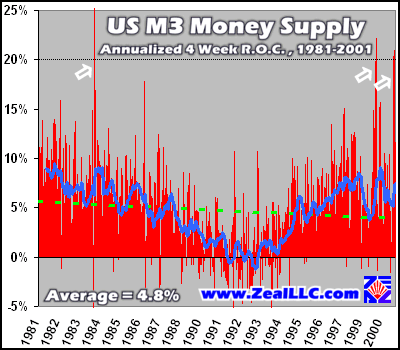|
|
|||||||
|
|
|
|
|
|
|
|
|
|
Exploding Inflation Adam Hamilton February 9, 2001 3605 Words
“When the inevitable consequences of inflation appear and prices soar, [people] think that commodities are becoming dearer and fail to see that money is getting cheaper. In the early stages of an inflation only a few people discern what is going on, manage their business affairs in accordance with this insight, and deliberately aim at reaping inflation gains. The overwhelming majority are too dull to grasp a correct interpretation of the situation. They go on in the routine they acquired in noninflationary periods. Filled with indignation, they attack those who are quicker to apprehend the real causes of the agitation of the market as "profiteers" and lay the blame for their own plight on them. This ignorance of the public is the indispensable basis of the inflationary policy.” - Dr. Ludwig von Mises, The Theory of Money and Credit, Chapter 21, 1912.
Ludwig Heinrich Edler von Mises was born on September 29, 1881 in the city of Lemberg, then part of the Austro-Hungarian Empire. The son of a distinguished construction engineer working for the Austrian railroads, Ludwig von Mises would grow into a living legend, becoming arguably the most important and influential free-market economist in world history. Ludwig von Mises was a tireless champion of free markets and individual initiative, and an arch nemesis of socialism and government interventionism. Although Mises passed away in 1973 at the full age of 92, the wealth of economic work he completed in his lifetime will be a priceless treasure for all of humanity as long as free men engage in commerce.
Ronald Reagan, former President of the United States and another outspoken champion of freedom and liberty and mortal enemy of socialism, had these glowing words of praise for Mises, “Ludwig von Mises was one of the greatest economic thinkers in the history of Western Civilization. Through his seminal works, he rekindled the flames of liberty. As a wise and kindly mentor, he encourages all who sought to understand the meaning of freedom. We owe him an incalculable debt.”
Ludwig von Mises’ phenomenally brilliant contributions to the science of economics cannot be overstated. He was one of those rare truly remarkable men who has left an indelible mark on history. He is a hero to all those who crave freedom and liberty, and loathe market manipulation and the rise of bloated, monolithic, and intrusive governments.
Mises was studying at the University of Vienna during the height of the great “Austrian School” of economics, and he became its greatest proponent. Austrian economics was a triumph over the rotten doctrines of classical economics, which centered around the concept of class warfare, ideologically pitting the employees against the providers of capital.
The virulent ideas of classical economics (which have now evolved into Keynesian economics) inspired Karl Marx to write the Communist Manifesto in 1848. The hate, misery, and destruction that sprung from Socialism and Communism (a Communist is simply a Socialist with a gun in a hurry) in the twentieth century is mind-boggling and beyond comprehension. The classical economics of class warfare bore some incredibly bitter and dangerous fruit.
The Austrian school of economics, in contrast to the dark and sad deceptions of Classical and Keynesian economic theories that lead to Communism and Socialism, extols the individual and his or her individual decisions in the economy. Individuals, acting in their own self-interest, make decisions of how and where they will spend their resources, and these virtually infinite individual decisions collectively become a free-market economy.
A free-market economy is the ultimate self-balancing machine. Adam Smith’s wonderful “invisible hand” concept demonstrates that surpluses and shortages are quickly remedied in the free markets by a change in the market price of an imbalanced good or service to re-establish market clearing equilibrium.
Ludwig von Mises became the widely recognized godfather of the Austrian economics philosophy. The first time one comes across Austrian economic thoughts after wallowing in the usual pro-Keynesian and pro-Socialist university curricula (read Leftist propaganda), it is like a breath of fresh air or a brilliant crystal sunbeam penetrating a dark room. Ludwig von Mises and the other great Austrian economists exposed all the myriads of falsehoods of classical economic thought and concentrated on the individual and the free market.
One of the pillars of Austrian economics is the relation of the money supply to the general price of goods and services. Money is a medium of exchange, and everything is priced in terms of money. An understanding of money is absolutely critical to truly understand the concept of “inflation”.
Today, as we watch bubblevision and the mainstream media, it is readily apparent that the popular definition of inflation is rising prices. This definition is at best incomplete and at worse a dangerous deception.
Due to this faulty understanding of inflation today, as well as cooked CPI numbers watered down with arcane statistical smoke and mirrors called hedonics (see our earlier essay Lies, Damn Lies, and CPI for an explanation of this farce), there is a general consensus that we live in a virtually inflation free era. In this essay, we build on the timeless truths Mises presented in “The Theory of Money and Credit” and look at current data from the United States Federal Reserve to attempt to refute the common fantasy that inflation is largely dead.
Like anything, the only way to study inflation is to understand what it truly is. Inflation, as the Austrian economists including Ludwig von Mises have recognized all along, is really a product purely of money supply, nothing else.
Inflation, in the true sense of the word, is an increase in general price levels that comes into existence when relatively more money is injected into an economy than new goods and services injected into that same economy. The supply of money defines inflation, per Mises and the Austrian school of economics. Although one would not realize this by following the mainstream media drivel, this Austrian definition of inflation is correct and true, and is not a radical idea. Webster’s massive current unabridged dictionary defines inflation as “a persistent, substantial rise in the general level of prices related to an increase in the volume of money and resulting in the loss of value of currency.”
The key to understanding inflation is it is a MONETARY phenomenon, not a supply/demand imbalance in a commodity. The energy markets of the last two years, for instance, are widely thought to be inflation. This thought is incorrect. Oil and natural gas demand has simply been higher than supply, so prices rose in order to re-establish a market-clearing equilibrium price and eliminate the supply and demand imbalance. Monetary inflation no doubt contributed slightly to these energy price increases, but the primary reason energy prices have been rising is growing demand outstripping dwindling supply.
In a relatively closed system, it is easy to understand how true inflation, monetary inflation, occurs. One excellent example centers around the North Slope of Alaska when the oil boom occurred a few decades ago. Before the oil, prices in towns such as Point Barrow were fairly normal, although a bit higher than prices in the US due to the logistical difficulties of transporting food and supplies through the Arctic Ocean that is frozen the majority of the year. As soon as the oil money began pouring into the North Slope area, prices of goods and services began to skyrocket.
All of a sudden a relatively closed community had a massive influx of new money paid to oil workers. When more currency chases the same amount of goods, prices rise. Money becomes less dear and folks are willing to offer more money for a given good or service. A hamburger that cost a dollar before the oil boom in Point Barrow probably cost 25 times as much after the oil money hit the community. Prices of other goods and services rose by a similar amount, as the deluge of fresh money sloshed through the Alaskan economy.
Relatively more money chasing a finite supply of goods and services virtually ALWAYS produces inflation!
If we zoom out to a macro level and view a nation state, the same fundamental basics apply. When the money supply grows rapidly and goods and services offered do not keep up, inflation is the result.
There are many fabulous examples of this phenomenon throughout history, including Germany after the First World War. One of the most entertaining ones surrounds the British rogue John Law in the early 1700s. John Law was forced to flee England in order to avoid prosecution for some alleged crimes. He traveled around Europe and eventually settled in France, where his powerful personality, incredible mind, and command presence ultimately brought him to the attention of the King of France.
Law convinced the King and the French monetary authorities that in order to have a perpetual business boom, all they needed to do was print enough fiat currency so that business was assured of having access to the capital it needed. Law stated that a stable gold-backed currency, which by its very nature stops meddlesome government bureaucrats from living beyond their means, was too archaic and far inferior to his new fiat currency theme. He assured the French ruling class that because the government would print money when more was needed and buy it back when there was a surplus of money, that there would not be inflation and business would have the optimum amount of capital to thrive. Unfortunately, the French powers that be bought into Law’s inflationist plan and executed the necessary monetary policy to make it happen.
Initially, Law’s plan seemed to be working brilliantly. In the 1720s, France experienced an incredible boom as vast amounts of new fiat capital flowed into the existing markets. Prosperity seemed to be everywhere, and the French stock market was exploding. Soon, ordinary folks were quitting their jobs to hang out on the street where securities were traded and they became day traders. Charles Mackay reports in his 1841 magnum opus “Extraordinary Popular Delusions and the Madness of Crowds” that one deformed hunch-backed man made large amounts of money renting out his slumped back as a mobile writing table for the frenzied stock jobbers buying and selling French equities on the street! The wild stories that came out of this particular mania are endlessly fascinating!
John Law became the most famous and loved man in France, accruing enormous wealth for himself.
He then convinced the French government to join him in forming a company to develop the fabled wealth of the Mississippi River, of which the French controlled the gateway with their colony of New Orleans. The Mississippi company was floated and everyone in France wanted to own shares of this hot new IPO. They were convinced that they would be able to retire in a year or two because of the legendary wealth that the Mississippi company would generate. Like hungry sharks boiling around a wounded whale, the people of France started a bidding war that propelled the Mississippi company stock and other French equities to dazzling heights.
In the meantime, like all exponential parabolic manias, the French bubble soon collapsed. The aftermath of the disastrous inflationary policy of creating money out of nothing was brutal, and the Mississippi Scheme is one of the most widely studied speculative manias and bubbles in all of history. The country of France and the French people bore the consequences of this monetary inflationary nightmare for decades, and some would argue France has never regained the prominence it had before the greatest inflationist of all time, John Law, took the reigns.
The man whom kings used to wait to consult was widely known as the “eldest son of Satan” in France after the bitter fruit of rampant fiat monetary expansion became apparent. Provocatively, reading accounts of the Mississippi Mania in France and its sister South Sea Bubble in England, which arose at the same time, is eerie in that the parallels with the US NASDAQ tech bubble of early last year are startling and profound. The lessons of history are never learned by governments and they continually repeat these same mistakes.
With Mises and the Austrian economists’ true definition of inflation in mind, a disproportionate increase in the money supply, let’s review the US money supply to determine if the popular pundits are right that there is no inflation in America at the moment.
The following graphs focus on the broad US M3 money supply. The first graph is from 2000 to the present. The red columns represent the 4 week rate of change in the money supply, annualized so the percentages are meaningful. Weekly M3 data direct from the US Federal Reserve was used to populate all the graphs in this essay. The dashed green line is the linear trend of each graph, and the solid blue line is a 25 week moving average of the 4 week rate of change.
With all the propaganda of no inflation in the States, one would expect money supply growth that was only slightly higher than the growth rate of GDP, say a few percent, right?
Ominously, the AVERAGE growth rate in the M3 money supply since early 2000 has been an astounding 6.7%! This is quite amazing because the GDP grew by a fraction of that, and was rapidly slowing down to around 2.4% in the last quarter of 2000. Both Alan Greenspan and Bush’s new SecTreas Paul O’Neill have alluded to ZERO growth in the US economy so far in 2001, so there is no doubt the economy is still slowing and is possibly recessionary already.
Even more incredible, however, the piece de resistance of the graph is the MASSIVE spike in M3 growth that was unleashed like a tidal wave on an unsuspecting beachside resort in late December and early 2000. This Mt. Everest of US monetary growth is marked by the yellow arrow and question mark, as if it doesn’t already stand out like a central banker at a Ralph Nader rally!
A 20% annual growth rate in the money supply is NOT what one would expect from the world’s primary economy. Growth like that is more in line with third world banana republics. Since the two 20%+ growth rate weeks in late December, M3 is still growing at a dizzying 11% to 13%. The really important question becomes… WHY? Have Greenspan and the Fed gone mad? What are the implications for near-future inflation in America?
Before we muse a bit on those important questions, it is helpful to obtain a broader more strategic perspective. How often do 20%+ spikes in M3 growth rates occur in modern history? First, we will take a look at the same dataset from 1995 to the present. The same conventions used in the previous graph apply…
One other similar spike is immediately evident in late 1999. The second to the last week of that year witnessed a 19.9% M3 growth rate, and the final week saw 22.1%. This, of course, was liquidity which Greenspan and crew injected into the economy due to Y2k concerns. Notice the Y2k spike was nowhere near as wide and sustained as the present M3 orgy. From the graph alone, it is readily apparent that the reasons for the current Fed goosing of M3 must be more compelling than Y2k. Take a second to think about that!
Regardless of your thoughts on Y2k then or now, you have to admit that there was a LOT of fear and uncertainty surrounding the date changeover. The current M3 spike makes the Y2k capital injection look as skinny as if it was living through a famine!
Note that the average growth rate of the M3 money supply for that six year period was above 6%, FAR exceeding the growth of the US economy as measured by GDP in the same period of time.
If unrestrained money growth causes inflation, the question should be asked… why didn’t we see dramatic inflation since 1995? Actually, the US DID witness massive inflation since 1995. Instead of inflation of goods and services, however, all this excess capital deluged into the US equity markets. Take a look at a ten year S&P 500 or DJIA chart and it is crystal clear that the US equity markets have gone ballistic since 1995. The Y2k spike in the M3 growth rate noted in the graph above was directly responsible for the parabolic blow-off of the NASDAQ in early 2000. Much of that excess fiat money created by the Fed for Y2k bid up the already stratospheric NASDAQ to nosebleed valuations, immediately before it crashed.
As John Law and the French government created the excess fiat currency that bid up the Mississippi scheme in France in the 1720s until it exploded, Alan Greenspan and the US Fed created the massive fiat capital excess, apparently for Y2k reasons, that forced the NASDAQ into its terminal trajectory.
Zooming out even further, let’s look at the M3 growth rate since 1990…
Wow! The fiat money excesses of 1995 to present and especially the current M3 mega-spike REALLY stand out with an eleven year longview! Interestingly, from 1990 to late 1994-early 1995, the 25 week moving average of the M3 growth rate (blue line) was relatively flat, hovering slightly above zero. At the midpoint in the graph, however, M3 growth literally exploded, slamming through 5% like an armor piercing bullet through plywood and rapidly approaching 10%. The Y2k spike and the current rampant fiat expansion look far more suspicious and anomalous with this longer-term perspective. The Y2k spike is understandable at least, in light of the information available at the time, but why the heck is the Fed inflating at banana republic rates RIGHT NOW?
A final extended look at the same data series is in order, from 1981 to the present…
One other mega-spike in M3 is apparent in 1984. Although it only lasted two weeks, M3 growth rates shot up to 28.5% and 26% in March 1984, off the scale of this graph. We do not know why this M3 spurt happened in 1984, and do not recall any extremely noteworthy events surrounding that month. Nevertheless, with only three episodes of 20%+ M3 growth rates in 20 years, it is quite obvious that they are NOT common and should be carefully investigated when they occur.
Looking at the blue 25 week moving average line, notice the parallels in the average level of M3 growth between the early 1980s and the late 1990s. In the early 1980s, everyone KNEW we were in an inflationary environment… virtually no one disputed the fact. During those times, the excess money was flowing into commodities and goods and services instead of financial assets. TODAY, the M3 growth rates are trending up and rapidly approaching 1980s benchmarks, yet most people and professionals today live in a Utopian fantasyland where inflation does not exist… what a joke!
If Ludwig von Mises was around to look at these graphs, we are positive he would say that they are a harbinger of much higher inflation in the near future. The gobs of fiat money created out of nothing by the wizards at the Fed have to go somewhere, and when it sloshes into its new home, prices will rise as more money chases relatively fewer goods and services. This law of economics is as immutable as gravity in physics, and it cannot be defied.
Now, back to the million-dollar question… WHY?
The latest M3 spike surrounds the unprecedented (in Greenspan’s “gradualist” career) 100 basis point interest rate slash and burn of January 2001. Greenspan and the Fed were obviously terrified that something appalling would happen if they did not goose the money supply and annihilate short-term lending rates to re-liquefy the economy. Whether the unseen specter is the California energy regulatory scheme blowing-up in the socialist regulators’ faces, some yet unknown derivatives disaster ala LTCM, or a systemic problem with the ultra-fragile US fractional reserve banking system, something IS definitely up.
The exploding money supply coupled with the emergency rate cuts are a very persuasive sign that the Federal Reserve is well into panic mode, and it probably has little to do with the imploding NASDAQ bubble.
All the mountains of new fiat capital being created by the Fed have to find their way somewhere, and no doubt Greenspan stays up at night sweating and praying that the new money seeks out the US equity markets instead of goods and services. Odds are, however, since the US equity markets are listing badly and foreign capital is fleeing the falling dollar, that the new money the Fed is pumping out at fantastic rates will soon become highly inflationary in the important goods and services of the general economy, and financial assets will continue to crumble.
M3 is exploding. Inflation will be exploding. The legendary Mises would no doubt shake his head in disgust at the inflationary policies the US Fed is knowingly undertaking in a desperate attempt to slow the rapidly unwinding excesses of the Kondratieff bubble. Greenspan and the US Fed have apparently embarked on an inflationist course that John Law would be proud of… Position your assets accordingly!
Adam Hamilton, CPA February 9, 2001 Subscribe |
|||||||
|
|
|
|
|
|
|
|
|
|
|
|
|
|
|
|||




